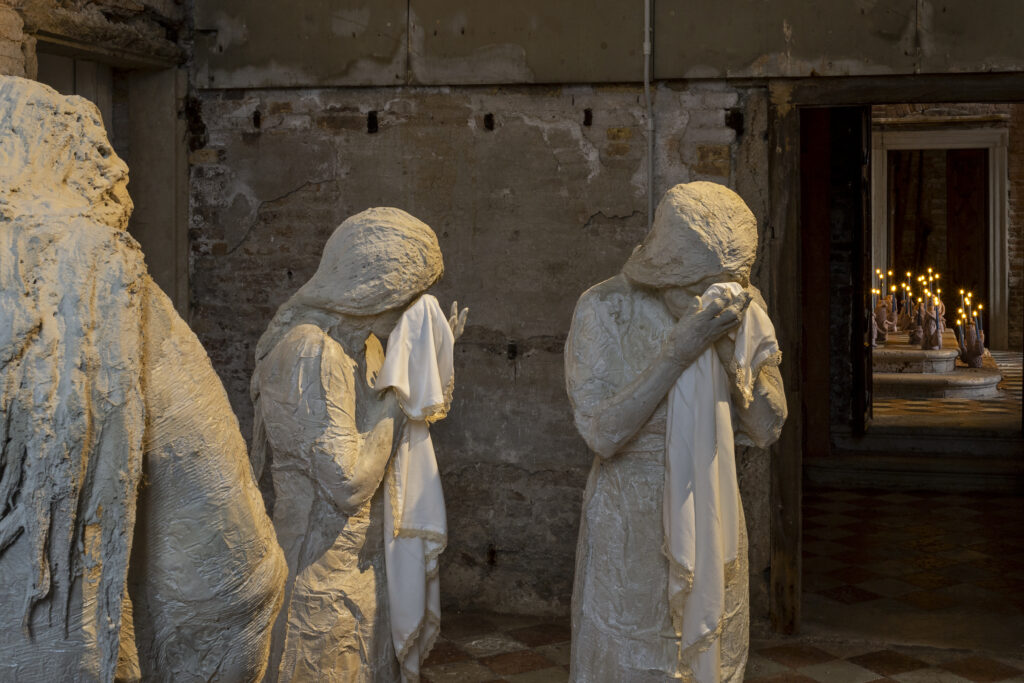
Today, on 19 April at 12.00 Estonia opened Hora lupi by Edith Karlson, the exhibition representing Estonia at the 60th International Art Exhibition – La Biennale di Venezia this year at the church of Santa Maria delle Penitenti. The exhibition remains open from 20 April to 24 November. The dramaturge of the exhibition is Eero Epner.
The title of the exhibition Hora lupi (hour of the wolf) refers to a mythical time before dawn, when things arise and disappear – an hour of deep darkness but also of transformation. It is believed to be the time of night, when the most people are born and die. The central motif of the exhibition is the primitive urges of man in their banality and solemnity, expressed in a vast array of sculptures created by Karlson. The new pieces created for the exhibition blend into the historic interior of the 18th century church no longer in use as a religious space, creating a unique and timeless atmosphere.
For the exhibition, Karlson has created a world on men, animals and anthropomorphic figures inspired by folklore and mythology. The exhibition also features a vast series of hand-crafted clay self-portraits created by people who surround the artist: children and elderly people, state officials and common workers. The faces are inspired by the 14th century terracotta sculptures in St. John’s Church in Tartu, Estonia, most likely depicting townspeople of the time. It has been suggested that the sculptures are a memorial ensemble commemorating the victims of the plague.
„I am thrilled to see that this long process has culminated with such a spectacular exposition that now stands before us in its joy and melancholy. I am particularly glad to have had a chance to work in a location with a rich history and particular atmosphere,” says Edith Karlson.
Edith Karlson is a sculptor who often presents her work as installation, using an entire exhibition space. Her works tackle the most inexplicable feelings and sensations in the current world: fear, melancholy, brutality and joy, which she transforms into material form, often in clay, concrete or found materials. Frequently working with animal forms and anthropomorphic figures, she approaches humans as animalistic beings whose impulses, wants, and desires are hidden just under the surface of their well-pressed suits. Karlson studied installation and sculpture at the Estonian Academy of Arts (BA, 2006; MA, 2008). She was awarded the EAA Young Artist’s Prize (2006) and Köler Prize People’s Choice Award (2015). Karlson is among the recipients of the national artists’ salary between 2018-2020 and 2022-2024 and was granted the Estonian Cultural Endowment’s main award (2020).
Eero Epner is an art historian, dramaturge and writer who has worked for the avant-garde theatre NO99 as well as with many Estonian artists. He worked with Edith Karlson for her last large-scale show Return to Innocence (Estonian Contemporary Art Museum, 2021). He was granted the Estonian Cultural Endowment’s award for researching and introducing the works of Konrad Mägi, an Estonian artist from early 20th century in 2017.
Participating since 1997, this is the 14th time Estonia is exhibiting at the Venice Biennale. The Estonian Centre for Contemporary Art is the official representative of the Estonian exposition and the pavilion is financed by Estonian Ministry of Culture.
For information about the Estonian entry for 2024, please contact international PR-advisor Alexia Menikou: am [at] alexiamenikou.com
Dramaturge: Eero Epner
Commissioner: Maria Arusoo (CCA)
Head of production: Sten Ojavee (CCA)
Technical team: Tõnu Narro and Mihkel Lember (Technical Director), Johannes Säre (Dream Team)
Communication team: Keiu Krikmann (CCA), Kaarin Kivirähk (CCA), Stina Pley, Alexia Menikou
Graphic designe: Jojo & me (Johanna Ruukholm and Martina Gofman)
Lighting design: Oliver Kulpsoo
Sound design: Raul Saaremets
Architect: Piero Vespignani
Project coordinators: Mikk Lahesalu (CCA), Marika Agu (CCA)
Italian coordinator: Valeria Romagnini
Artist’s team: Art Allmägi, Sander Haugas, Kirsti Kaubi, Loora Kaubi, Ats Kruusing, Erik Liiv, Maria Luiga, Eva Mahhov, Liisi Põllumaa, Nikolai Saaremets, Elo Vahtrik, Hanna Samoson, the artist’s dogs Iti and Kusti
The artist would like to thank
Katrin Kissa, Ene-Liis Semper, Raul Saaremets
Commissioned and produced by
Estonian Centre for Contemporary Art (CCA)
Financed by
Estonian Ministry of Culture
With the support of
Postimehe Fond, Taavet+Sten Tulevikufond, Cobalt Law Firm, Cultural Endowment of Estonia, DSV Global Transport and Logistics, Põhjala Beer, Selver, Uus Rada Galerii, Tallinn Zoo, Estonian Museum of Natural History, Müürileht, Estonian Academy of Arts, Pallas University of Applied Sciences